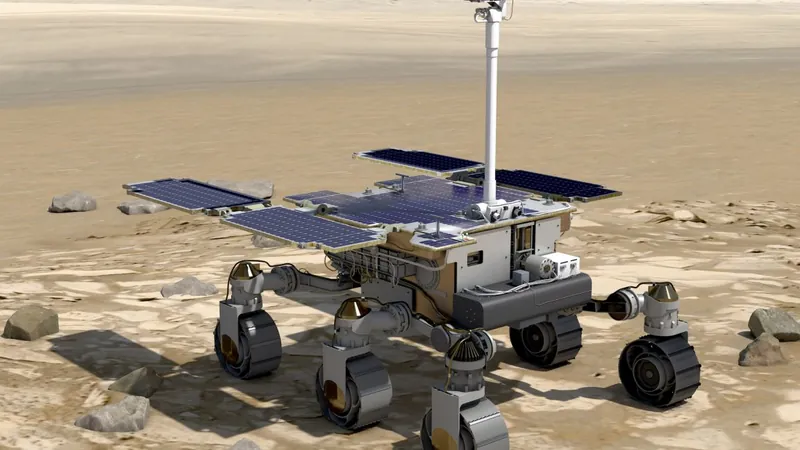
Europe's Troubled Journey to Mars: Will ExoMars Finally Succeed?
2025-03-31
Author: Lok
The ExoMars mission has become a saga of ambitious goals and unending setbacks. Launched by the European Space Agency (ESA), this marks Europe’s third attempt to successfully land on the Red Planet, with a staggering budget of over $1.3 billion at stake. But does the mission have what it takes to overcome the myriad obstacles it faces?
In a significant development this past Sunday, the ESA announced that Airbus will be tasked with designing and constructing the lander that will deliver the ExoMars rover to Mars' surface. The anticipated launch is set for no earlier than 2028, utilizing a rocket from the United States. However, the long and tumultuous history of the ExoMars mission raises questions about its future viability.
A Long and Twisted Path
The journey began back in December 2005 when the ESA first committed to funding ExoMars during a ministerial meeting. Initially planned for a 2011 launch using a Russian Soyuz rocket, the mission underwent constant changes. By 2009, discussions with NASA led to plans for an Atlas V rocket launch, but these shifted dramatically back to a partnership with Russia’s Roscosmos to use a Proton rocket for launch.
As funding problems arose alongside expensive endeavors like the James Webb Space Telescope, NASA pulled out of the project, stirring resentment among European policymakers who relied on strong partnerships for success. With NASA’s departure, Russia stepped in more prominently, not only providing the launch vehicle but also vital components for the spacecraft's entry, descent, and landing strategies.
Technical difficulties proliferated, causing several timeline shifts. Originally slated for 2011, the mission was delayed to 2018, then postponed to 2020 before being pushed back further to 2022 due to a series of parachute testing failures and, eventually, the COVID-19 pandemic.
Geopolitical Turmoil
The geopolitical landscape shifted dramatically when Russia invaded Ukraine in early 2022. This invasion led the ESA to terminate its collaboration with Roscosmos, igniting tensions between Russia and Europe. The response from former Roscosmos head Dmitry Rogozin was sharp, criticizing ESA leadership harshly. However, following these events, ESA turned to NASA for renewed collaboration. NASA agreed to support the mission with rocket supplies and critical engineering assistance—an unexpected lifeline for ExoMars.
Fast forward to the present day, and Airbus is set to construct the landing platform for the mission alongside the Rosalind Franklin rover. Kata Escott of Airbus emphasized the unique international challenge of securing the rover’s successful landing on Mars, which echoes over 20 years of arduous work.
What Lies Ahead?
Despite the recent positive developments, uncertainty still looms. This marks the third version of the lander being developed, with two previous European attempts—the Beagle 2 in 2003 and Schiaparelli in 2016—both culminating in failure. Preparations must be meticulous to avoid similar pitfalls.
The window for launching to Mars opens in December 2028 and lasts into early 2029. However, the landscape is not solely shaped by technological challenges. International dynamics play a crucial role; NASA's renewed focus on Mars explorations under the current US administration could see SpaceX's Starships launching missions to the Martian surface, potentially complicating the ExoMars mission further.
With all these factors in play, the only certain takeaway regarding ExoMars is the expectation of unforeseen surprises. Will 2028 finally be the year Europe makes its mark on Mars? One can only hope and wait, as this enigmatic space odyssey continues.



 Brasil (PT)
Brasil (PT)
 Canada (EN)
Canada (EN)
 Chile (ES)
Chile (ES)
 Česko (CS)
Česko (CS)
 대한민국 (KO)
대한민국 (KO)
 España (ES)
España (ES)
 France (FR)
France (FR)
 Hong Kong (EN)
Hong Kong (EN)
 Italia (IT)
Italia (IT)
 日本 (JA)
日本 (JA)
 Magyarország (HU)
Magyarország (HU)
 Norge (NO)
Norge (NO)
 Polska (PL)
Polska (PL)
 Schweiz (DE)
Schweiz (DE)
 Singapore (EN)
Singapore (EN)
 Sverige (SV)
Sverige (SV)
 Suomi (FI)
Suomi (FI)
 Türkiye (TR)
Türkiye (TR)
 الإمارات العربية المتحدة (AR)
الإمارات العربية المتحدة (AR)